These people has some nasty little dogs that apparently HATED wood. Yeah, our floors were ugly. But we knew underneath the mess, there was an oak beauty that just needed a little microdermabrasion to look fabulous at age 72!
Supply list
orbital or drum sander
100 times more sandpaper than you think you'll need for the sander, in a selection of grits: 20, 36, 60, 80, 120
palm sander (ditto on the sandpaper)
pole sander
shop vac
dust masks, safety goggles
rags or foam brushes for stain
lamb's wool applicator and natural bristle brush for poly
tack cloths
plastic dropcloths
stain of choice
poly of choice
Prep
The first thing we did was make sure that we couldn't see a lot of staples or nails in the floor, if we had, it would indicate that the floor had already been sanded too many times and couldn't handle another sanding. We didn't have any large spaces between the boards, if there had been spaces, we would've filled them before the sanding process.
- We removed everything that wasn't nailed down and swept the floor thoroughly.
- We didn't have any carpet in this room, but if you do, use pliers to pull out any leftover carpet staples and use a hammer and nailset to sink any exposed nails that may damage the sander.
- We left the baseboards, but if you plan to replace them, use a shim behind the pry bar to avoid damaging the walls while removing them.
- To avoid spreading dust throughout the house, we hung plastic over the room's doorways, fireplace, and vents. We DID NOT do this right away and were quite annoyed with our stupidity. Take the time to seal up everything or you will be sorry later! Please see our dining room as proof - talk about a 'before!'
We chose to rent an orbital sander because it is more forgiving than a drum sander. A drum sander works faster, but carries a greater chance of gouging your floors. Sanding floors is a horrible, nasty, dusty, noisy job. You'll want to wear a
- Start out with a course paper (20 to 36 grit). Begin in a low visibility area like under a sofa, just in case! Start the sander with the drum off the floor and slowly lower it onto the wood. Here's the really bad area after the first pass with the sander:
- Don't be scared of the sander! It takes some getting used to, but with a little practice, you can do it as long as you're careful. You can be a wee less careful with the orbital, because it isn't as powerful as a drum.
- Walk the sander forward, with the grain of the wood. Sand from wall to wall, making both a forward and a backward pass of each row. CAUTION: Never let the sander sit in one spot. It can make a gouge or swirl mark in just seconds.
- Where the sander can't reach, at wall edges and corners, use an edge or palm sander. Edge sanders are like mini orbitals, and can be rented. We used two regular palm sanders with fine results, but an edge sander would've worked faster.
Check out the vintage hallway shot! Complete with baby-poop paint and gross carpet!
Finish Sand
- After the rough sanding, change to a medium (50-60) grit. Go over the entire floor the same way. After this pass check again for cracks/holes and use matching wood putty to fill them in. Also look for nailheads. Countersink them and fill them in.
- For the final sanding, use a fine (100-120) grit and finish with a palm sander around the edges. Make sure you have ALL the finish off or your stain will be blotchy.
- Vacuum the room thoroughly, including the walls, window trim, ceiling, any places where dust can hide. Use tack cloths attached to Swiffer mops to really get all that dust up. Don't use a damp rag because moisture will raise the grain of the wood.
Stain
We chose an oil-based stain (Old Masters 'Cedar') because it goes on easy and looks gorgeous on the wood. Water-based are becoming more popular, but oil-based is the standard for professionals because it gives a richer color.
- We used t-shirt rags to apply the stain, cutting in from the corners and working with the wood grain. Wipe off any excess and change rags often. It's not always a great idea to put on two coats of stain, but we weren't really happy with the depth of the color after the first coat, so we did another coat. It's better to make sure your stain is as dark as you want it from the start because more coats could mean blotchy results - especially true with dark stains like the espresso shade on our stairs. We have a slight footprint mark in the floor that is hilarious and annoying because we walked on the first coat of stain with our socks a bit too soon to put on the second coat. Here's my fabulous mom on the first (too light) coat:
- Let the stain dry out overnight and avoid walking on the floor so you don't have footprints like we do!
We chose oil-based satin polyurethane for our coating. There are good water-based polys out there, but we are traditionalists, so we went with oil knowing that it will eventually develop a nice amber glow. Water-based will not amber over time, and will dry faster - this is a bad thing for beginners that need more time to work with the wet poly! Oil-based is also thicker, more durable when dry, and takes less coats than water-based. It's just personal preference. We originally decided to do 3 coats (pretty standard) but then had to do 4 due to user error. Make sure you have good light coming in while working, or you will not be able to see where you poly'd and where you didn't.
- Use a high quality natural bristle brush or foam applicator to cut in along the edges and corners. Avoid drips and thick overlaps of finish. We used bristle brushes and tried to be careful to avoid overlap marks. If you brush into the wet area and lift up your brush, you won't have a line. If you put your brush down in the wet and move it towards you, you will have a line. Move into the wet portions, not away from them. This feel awkward, but it's the best way. I'm not going to lie, our first three poly coats looked like drunken monkeys had applied them, because we had tried to apply all the poly with brushes, instead of using an applicator. Hey, you learn!
- Start at the farthest point from the doorway (don't poly yourself into a corner, mkay?) and apply an even coat of poly with a lambswool applicator. Before you use the applicator, make sure to use tape to remove any fuzzies and also use a bit of mineral spirits on a rag to wipe it down. DO NOT skimp on the applicator, buy real lambswool applicators that screw onto a broom handle, the cheap ones will leave you with a hairy floor. While the finish is still wet, blend in any brush marks from your edging with the big applicator.
- Between each coat, scuff-sand the floor lightly with a pole sander fitted with 150 or 220 grit sandpaper. This is very important, because once the poly hits the wood the grain will lift and cause roughness. Sanding also improves adhesion and makes sure you get a glassy finish. Vacuum, use tack cloths (and a slightly damp rag if needed) to make the surface dust free before the next coat. Don't sand the final coat, though :)
- Let the finish dry for 24 hours between coats, unless using the quicker drying water-based urethane.
- Don't put down any furniture or rugs for at least a week after your last coat. We didn't put anything in this room for an entire month because I was worried the 4 coats wouldn't be completely dry. I'm glad I overcompensated, because we did not have any dings or dents in our finish. We are so happy with our floor! Too bad we will be doing this many more times before we're finished with all our floors...


.JPG)

.jpg)
.jpg)
.jpg)
.jpg)
.jpg)
.jpg)
.JPG)
.JPG)
.JPG)
.JPG)
.JPG)
.jpg)






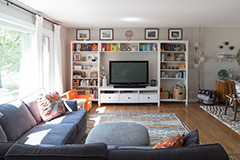
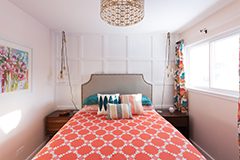
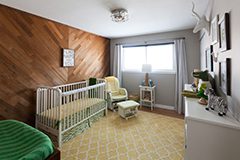
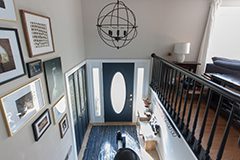

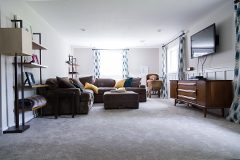
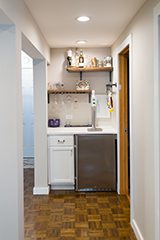
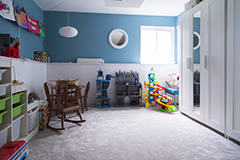
Beautiful! Your hardwork paid off. We uncovered our floors over the summer!
ReplyDeleteI love hardwood! Our home is only 13 years old, so we had to purchase new hardwoods. Somehow I think it would be better to pull back the carpet and have the wood floors just waiting for us. (It would also be more cost-effective, since we paid a professional to install our floors.) I think our next house will be an older fixer-upper.
ReplyDeleteYour floors look fantastic!! And it's so awesome that you were able to refinish them yourself and have them come out so good!!
ReplyDeleteYour floors are beautiful! Y'all did an awesome job! Thanks for the tutorial!
ReplyDeleteAwesome floors and thanks for the DIY tips. I recently had my 100+ year old hardwood floors redone and LOVE it. However may buy a cabin and plan to do the floors myself so your tips will come in handy.
ReplyDeleteSara - grea work on the floors. They look awesome. We did our floors, too. Check it out here if you have time, http://newlywoodwards.blogspot.com/2009/08/got-wood.html
ReplyDeleteThanks!! I read a quick read though (I'm at work!) I can't wait to re-read it! Our floors our orignal from 1956, and we so can't wait to refinish them...thanks for the setp by step
ReplyDeleteWell worth all your effort ... the floors look great.
ReplyDeleteI will definitely be referring back to this in a couple months.
ReplyDeleteYAY! I will definitely be bookmarking this for when we refinish our floors. It looks SO good!!
ReplyDeleteAMAZING transformation! Kudos to you guys!
ReplyDeleteWOW! What an amazing job! The floors look fantastic!
ReplyDeleteOh. My. God. That is such a huge improvement! Your mom is sooo sweet for helping you out! It all looks amazing and I love the color you picked for the hallway.
ReplyDeleteYour floors are lovely. You are one patient, talented woman and that is a great tutorial.
ReplyDeleteyour floor turned out BEAUTIFULLY!!!
ReplyDelete